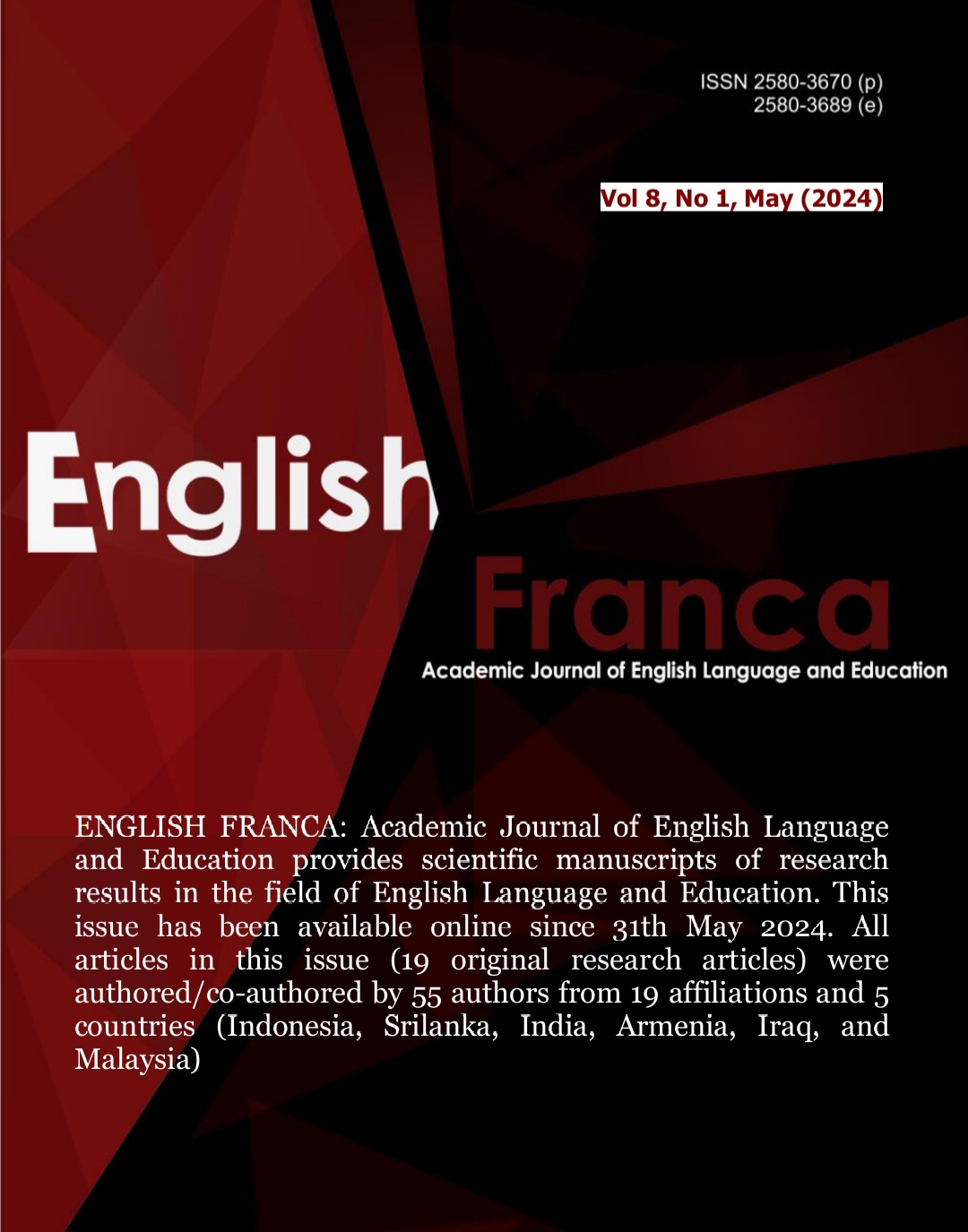Pronunciation Errors in Speaking Committed by Non-Majoring English Students: Causes and Solution
DOI:
https://doi.org/10.29240/ef.v8i1%20May.9513Keywords:
non-majoring English students, pronunciation and grammatical errors, speaking skill.Abstract
Downloads
References
Ababneh, I. (2018). English pronunciation errors made by Saudi students. European Scientific Journal, ESJ, 14(2), 244–261.
AbiSamra, N. (2003). An analysis of errors in Arabic speakers’ English writings. Investigating Writing Problems among Palestinian Students Studying English as a Foreign Language. Unpublished Doctoral Dissertation, P5.
Abukhadrah, Q. A. (2015). The Difficulties of Learning English as Perceived by a Group of International Students: A Case Study. International Journal of English Language Teaching, 3(8), 40–48.
Achmad, D., & Yusuf, Y. Q. (2014). Activities to overcome EFL learners’ pronunciation problems. RATE Issues (Summer).
Adams-Goertel, R. (2013). Prosodic elements to improve pronunciation in English language learners: A short report. Applied Research on English Language, 2(2), 117–128.
Ahmed Al-Tamari, E. (2019). Analyzing speaking errors made by EFL Saudi university students. Arab World English Journal (AWEJ) Special Issue: The Dynamics of EFL in Saudi Arabia.
Al-Khresheh, M. H. (2016). A review study of error analysis theory. International Journal of Humanities and Social Science Research, 2, 49–59.
Amara, N. (2015). Errors correction in foreign language teaching. The Online Journal of New Horizons in Education, 5(3), 58–68.
Brown, D. H. (2007). Principles of language learning & teaching. (5th Eds.). Pearson: Longman.
Dörnyei, Z. (2007). Research methods in applied linguistics.
Ellis, R., & Barkhuizen, G. (2009). Analyzing learner language. Oxford university press.
Fitriani, N., & Zulkarnain, S. I. (2019). Vocational college students’ common errors in EFL speaking performance. Studies in English Language and Education, 6(1), 141–151.
Heydari, P., & Bagheri, M. S. (2012). Error Analysis: Sources of L2 Learners’ Errors. Theory & Practice in Language Studies, 2(8).
Hojati, A. (2013). An investigation of errors in the oral performance of advanced-level Iranian EFL students. Mediterranean Journal of Social Sciences, 4(4), 171.
Jafari, S. S. (2013). Motivated learners and their success in learning a second language. Theory and Practice in Language Studies, 3(10), 1913.
James, C. (2013). Errors in language learning and use: Exploring error analysis. Routledge.
Keshavarz, M. H. (1994). Contrastive analysis and error analysis. Rahnama Publications.
Khansir, A. A. (2012). Error Analysis and Second Language Acquisition. Theory & Practice in Language Studies, 2(5).
Louis, C., Lawrence, M., & Keith, M. (2018). Research methods in education (8th ed.). Routledge.
Nunan, D. (2003). Practical English language teaching.
Patton, M. Q. (2002). Qualitative research and evaluation methods. Thousand Oaks. Cal.: Sage Publications, 4.
Rahmaniah, R., & Asbah, A. (2019). The Speaking Difficulties Encountered by Non-English Students in Language Classroom. Linguistics and ELT Journal, 6(2), 22–25.
Ramasari, M. (2017). Students Pronunciation Error Made in Speaking for General Communication. Linguistic, English Education and Art (LEEA) Journal, 1(1), 37–48.
Sembiring, N., & Fiber, Y. A. (2016). An Analysis of Pronunciation Errors Made by the Fourth Semester Students of English Education Study Program at UNIKA. Jurnal Suluh Pendidikan, 3(1).
Subandowo, D. (2017). The language interference in English speaking ability for EFL learners. Proceedings of ISELT FBS Universitas Negeri Padang, 5, 205–210.
Ts, A. S. (2020). The Dominant Errors of Speech Production Committed in Speaking Class Interaction. Pedagogy: Journal of English Language Teaching, 7(2), 136–144.
VÅ©, T. N. L. (2013). Grammatical errors made by English major students at Hai Phong Private University when speaking English and the solutions. Äại há»c Dân láºp Hải Phòng.
Downloads
Published
How to Cite
Citation Check
License
Authors who publish with this journal agree to the following terms:
- Authors retain copyright and grant the journal right of first publication with the work simultaneously licensed under a Creative Commons Attribution License (CC BY-NC-SA 4.0) that allows others to share the work with an acknowledgment of the work's authorship and initial publication in this journal.
- Authors are able to enter into separate, additional contractual arrangements for the non-exclusive distribution of the journal's published version of the work (e.g., post it to an institutional repository or publish it in a book), with an acknowledgment of its initial publication in this journal.
- Authors are permitted and encouraged to post their work online (e.g., in institutional repositories or on their website) prior to and during the submission process, as it can lead to productive exchanges, as well as earlier and greater citation of published work (See The Effect of Open Access).









